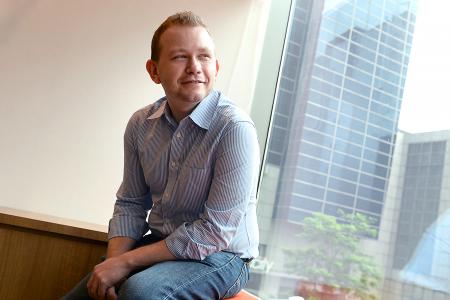How a bone marrow transplant saved his life 20 years ago
When The New Paper first interviewed him in 1996, he was 11 and about to get a life-saving bone marrow transplant. On the 20th anniversary of his transplant, TAN TAM MEI (tammei@sph.com.sg) catches up with the young man who overcame the odds
He would notice doctors at the National University Hospital speaking in hushed whispers around him.
Then only 11, Daniel Prior would tell himself, "Oh god, this must be it".
He was diagnosed with acute myeloid leukaemia, a strain of aggressive blood cancer that did not respond well to chemotherapy.
Doctors told the Prior family that finding a bone marrow donor was their eldest son's only chance of survival.
For six months, the family trudged through what his mother, Ms Jane Prior, described as a "ghastly tunnel".
They kept a military-like schedule, with mum, dad and grandmother taking shifts and time out to care for the boy24/7 when he was warded for over six months.
The light at the end of the tunnel came when an Australian donor, whose bone marrow matched Mr Prior's, was found.
This was done with the help of the Bone Marrow Donor Programme (BMDP), a non-profit organisation that manages the local database for volunteer donors.
The New Paper, which ran a report on Mr Prior when he first got a donor, caught up with Mr Prior, now 32, and his mother last Wednesday, just a week after the 20th anniversary of his "new life".
The Singapore-born Mr Prior, whose mother is British and whose father is Australian, has two younger siblings, aged 30 and 28.
Recalling the grim months, he said: "When you've got tubes sticking out of your chest, even as a kid you know that something's not normal.
"But every few weeks, we'd be celebrating a new milestone in my treatment, those were some of the better days."
His mother added: "Everything back then is somewhat a blank... Every day, we just got up and did what we had to do.
"We told ourselves, 'As long as there's hope of a transplant, we'll go on. Run, walk, march, don't stop.'"
Ms Prior also admitted that not everyone is as lucky as her family, and that is one of the reasons she joined the BMDP as a full-time staff member four years ago. (See report, above.)
"It was six months of absolute terror, and after going through it all, I want to help others," she said.
After the transplant in October 1996, Mr Prior took a two-year break from school to rebuild his immune system. He went on to complete his Higher School Certificate, the equivalent of A levels, and moved to Australia, where he got a degree in business.
Mr Prior worked in the hospitality sector in Sydney for nine years before recently returning to Singapore after completing a master's degree in environmental management. He is looking for a job here.
Mr Prior, who also volunteers at BMDP, said: "(The transplant) was a cure. I'm 100 per cent back to normal.
"Perhaps the only new thing is that I've got the blood of a strapping blonde Australian woman running through me," he added with a laugh.
The Priors now consider the bone marrow donor, Ms Pamela Elliott, 70, a part of the family.
They met for the first time in 1998 and have kept in contact ever since.
Ms Elliott, who lives in Queensland, Australia, told TNP via e-mail that she never thought she would one day save a young boy's life.
She said: "There was never any question whether I would go through with the donation and it was explained to me that there may be some pain afterwards. There wasn't, by the way.
"My only concern was keeping healthy in the two weeks before donation day. If anything happened to me in that period, Daniel would have no chance."
The mother of two adult children, who has since become a grandmother of four, added: "I was so thankful that I was needed for Daniel.
"In a way, I had been in the right place at the right time, that itself was a pretty humbling experience."
Transplant gives patients a second chance at life
Bone marrow donation procedures are generally very safe and have few reported complications, said Dr Yvonne Loh, a specialist in haematology and consultant at Raffles Cancer Centre.
A bone marrow transplant replaces diseased bone marrow with a healthy one from a donor and introduces a new immune system into the recipient.
Dr Loh said there are two methods of transplant - traditional bone marrow donation where bone marrow is extracted from the pelvic bone through a short procedure, and peripheral blood stem cell donation where bone marrow cells are collected through a blood-donation like procedure.
Risks for the first method include infections or bleeding from the puncture site, but these are rare, and side effects of the second method include bone aches.
"However (for both procedures), all that is donated grows back within weeks so there is no permanent loss of cells," she said.
Bone marrow transplants give patients a chance of a cure and Dr Loh hopes more Singaporeans will join the pool of potential donors in the Bone Marrow Donor Programme.
While the transplant involves potential risks for patients as their immunity is severely weakened to allow the donor's immune system to settle into their bodies, many of them are able to lead normal lives after the transplant and the initial recovery period.
Dr Loh said: "There are thus many bone marrow transplant survivors walking in our midst, living normal lives and many looking perfectly normal with normal life spans.
"It is estimated that bone marrow transplants can cure up to 80 per cent of acute leukaemia patients, many of whom would otherwise have lost their lives to this deadly disease within six months of diagnosis."
 THEN: When he was battling leukaemia, Daniel raised funds for the Bone Marrow Donor Programme by selling handmade friendship bands. TNP FILE PHOTO
THEN: When he was battling leukaemia, Daniel raised funds for the Bone Marrow Donor Programme by selling handmade friendship bands. TNP FILE PHOTO
FROM VOLUNTEER TO CEO
She started out as a volunteer at the Bone Marrow Donor Programme (BMDP), intending to give back to the group that had helped to match her son with a bone marrow donor.
Four years ago, Ms Jane Prior (below) became its chief executive.

Set up in 1993, the BMDP is a non-profit organisation responsible for building and managing Singapore's only register of volunteer donors. These donors are willing to donate their bone marrow and, more recently, their stem cells, to save the lives of patients with leukaemia and other blood diseases.
BMDP has overseen more than 500 successful bone marrow matches. It also provides a 365-day service to hospitals here to search the local register and, if necessary, partner registers around the world for a match.
The group launched a campaign this year in the hopes of recruiting 50,000 donors to add to its current 62,000 by 2018.
Anyone aged between 17 and 49 and in good health can sign up as a donor at www.bmdp.org.
A cheek swab kit and a form will be sent by post. A donor is asked to donate bone marrow only if he or she is found to be a match for a patient.
Get The New Paper on your phone with the free TNP app. Download from the Apple App Store or Google Play Store now


